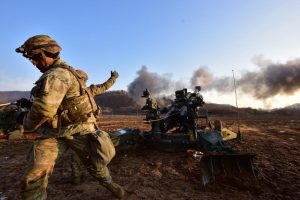On Sunday, North Korea exhorted South Korea and the U.S. to halt their joint military drills immediately.
“Recently, the U.S. and South Korea have put the situation in the Korean Peninsula on an extremely dangerous level through threatening rhetoric and military demonstration against the DPRK,” Kim Son Gyong, vice minister for international organizations of the North’s Foreign Ministry, said in a statement published by the state mouthpiece Korean Central News Agency (KCNA). (DPRK is an acronym of North Korea’s official name: Democratic People’s Republic of Korea.)
Under the purpose of strengthening the United States’ extended deterrence in the region, the South Korean and U.S. militaries have staged the U.S. strategic assets in the region to enhance their joint corresponding capabilities against the North’s nuclear and missile threats. That provides a visible embodiment of the United States’ promise that “[t]here is no scenario in which the Kim regime could employ nuclear weapons and survive.”
As more powerful and advanced U.S. military assets have been mobilized in the recent drills, North Korea again tried to frame the military exercises as an act of escalating tensions on the Korean Peninsula.
“The situation in the Korean Peninsula and the region is developing toward a very worried orientation, [which] no one wants, owing to such irresponsible acts of the U.S. and South Korea for escalating tension,” Kim, the vice minister, said.
According to the South’s Joint Chiefs of Staff (JCS) and the United States Forces Korea (USFK), Freedom Shield, a springtime joint military exercise, will be held from March 13 to March 23. The militaries will also conduct a large-scale field training, called Warrior Shield, marking a return to the mass exercises last seen in the early part of the Moon and Trump administrations.
“Freedom Shield is designed to strengthen defense and response capabilities of the Alliance by focusing within the exercise scenario on things such as the changing security environment, the DPRK aggression and lessons learned from recent wars and conflicts,” Col. Isaac Taylor, the spokesperson of the United States Forces Korea, said during a joint press conference on Friday.
When the inter-Korean dialogue and nuclear talks were taking place under the presidencies of Moon Jae-in and Donald Trump in 2018 and 2019, the scale of the South Korea-U.S. joint military drills was downsized in efforts to lead the North Korean leader Kim Jong Un to make substantive steps for denuclearization.
However, talks fell apart after the 2019 Hanoi summit between Trump and Kim Jong Un ended with no deal. Last year, Pyongyang launched an unprecedented series of ballistic missiles including its intercontinental ballistic missiles and submarine-launched ballistic missiles while ignoring Seoul and Washington’s efforts to renew the dialogue. South Korea, now under hawkish President Yoon Suk-yeol, and the United States responded by rapidly expanding their joint military activities. As a result, the arms race has intensified in the Korean Peninsula.
“Frequent joint drills of the U.S. and South Korea, which set such unrealistic and extremely dangerous purpose as ‘regime end’ of a sovereign state and are aggravating the regional situation even with all sorts of threatening rhetoric is, indeed, vivid evidence that helps us have a clear understanding of why the vicious cycle of tension has lasted in the Korean Peninsula,” Vice Minister Kim said.
A day before Kim’s statement was published on Sunday, KCNA published an article by Ku Yong Chol, a researcher at the North’s Foreign Ministry, arguing the United States and its allies brought “the crisis of collapse” of the international disarmament system and stating that North Korea’s efforts to bolster its nuclear capabilities will continue.
“The DPRK’s nuclear deterrent serves as a powerful physical guarantee for ensuring the balance of force in the region and preventing the outbreak of a new war, under the present situation in which the international disarmament system has to get unsubstantial [sic] and the danger of armed conflict is increasing on the Korean Peninsula due to the unilateral arms buildup of the U.S. and its allies,” Ku said.
Ku also justified the North’s nuclear buildup as a self-defense posture against the U.S. forces deployed in the region and the arms buildup of neighboring countries such as South Korea and Japan. He also stated that the possession of nuclear combat strength “is the best way for ensuring the maximum military deterrence at the minimum cost” – which has been the North’s main logic to rationalize its nuclear development since the end of the 1950-1953 Korean War.
“The DPRK’s line of bolstering up the nuclear forces is the most proper measure for substantially guaranteeing peace and stability in the Korean Peninsula and the region to cope with the reckless arms race by the U.S. and its followers,” Ku said. “The U.S. can never evade the blame for wrecking the global peace and security and bringing down the international disarmament system.”

































